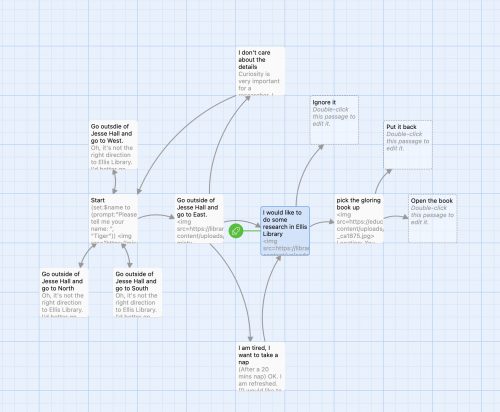Narrative Game Design-The Hidden Map of MU
This is an assignment from the course 2023FS-IS_LT-7384-01 Designing Games for Learning. I have been trying to use the takeaways from the course to design a game to help more students like me, as a new on-campus student in the University of Missouri to better understand the geographic and historical details about the beautiful campus. There are a lot of meaningful and interesting details hidden in the campus, by playing my twine game, I hope the players can be more confident to engage in MU, and be more proud to introduce MU to their friends and family members as MU ambassadors. During the process of designing my game, the criteria for what qualifies as a solid game narrative(Berger, n.d.) helped me a lot:
- Are the story milestones exciting and/or compelling?
- Is the character development organic and gradual?
- Does the narrative have a relationship to the gameplay, or is it independent of it? To what degree is the latter? Do the actions from the narrative have consequences on the gameplay? Does the gameplay have consequences on the narrative?
- Is the narrative frictionless? Or is the fun being interrupted too many times in order for me to follow a story that is not interesting?
- Does the story fit with the rest of the game? Is it tonally consistent? Is the pacing consistent?
- Most importantly, am I emotionally invested?
I can’t agree more with Annakaisa Kultima’s point, “The game ideas arise from solitude and mature by bouncing” (Kultima, n.d.). At the very beginning of my game design, there was only a blight and blurred thought that I wanted to design a game that could help more students like me as a new resident in Columbia, Missouri.
Game Title:The Hidden Map of MU
Learning Topic and Objectives
This game is designed for all the learners who want to know more about Mizzou, especially for the new MU students. The gamification learning journey aims to familiarize the learners with the knowledge about the MU campus and increase learners’ interest in MU history, including fun facts. To fulfill this goal successfully, the following learning objectives should be accomplished:
- By the end of this game, the players will be able to discuss with their friends three or more hidden history stories of MU.
- By the end of this game, the players will be able to support human rights.
- By the end of this game, the players will be able to evaluate the value of learning.
Intended Audience
New On-campus students at the University of Missouri.
Twine Prototype URL
Plot Summary
A new graduate student (players type their names) enrolls in the University of Missouri-Columbia (MU), and embarks on his or her new school year. This is the player’s first time to step on MU’s historic campus. Columbia, Missouri is a small town, which is different from the player’s previous life experiences. The player is struggling to get used to the new life and finds himself or herself drawn to the rich history of MU. As an eager learner, the player wants to find more answers to his questions on the campus by reading more books or talking to some gurus. By chance, in a corner of the Ellis library, the player finds an old map, and then a magical time-travel journey begins while the player reads the map. The player witnesses the big fire in the Academic Hall and a lynching at the Stewart Road Bridge, and he talks with Thomas Jefferson and other famous people related to MU. During the process of the player’s time-travel journey, a lot of historical details will be shown. Back to real life, the player becomes more familiar with MU. The player is new but knowledgeable about MU and can help more people to know MU’s hidden history.
Map the Story Progression
| Narration | |
| Background | Even if you believe that you are so familiar with the University of Missouri, Columbia campus, there are some places or hidden histories you may not know. So, this educational game The Hidden Map of MU, is designed for you and other new students at MU. The player will have a fantastic “campus exploration” to travel between different times in history and places on campus. The player will be involved in firefighting to witness the origin of “the Columns (Links to an external site).” and try to stop a lynching at the Stewart Road Bridge (Links to an external site.), talk with Thomas Jefferson, whose family gave his original tombstone (Links to an external site). to MU, a grumpy senior man will talk to the player about his understanding about education after he got his honor Doctoral Degree of Laws, the senior man has a written name, Mark Twain (Links to an external site). Mort Walker (Links to an external site). is in his 20s to chat with the player about his comic dream… The style of the game will be similar to the movie Midnight in Paris.(Links to an external site). |
| Conflict | The player as a new resident in Columbia, Missouri, is embarrassed in a lot of areas. The Hidden Map of MU makes the player more confident. The player talks with Thomas Jefferson, Mark Twain, and Mort Walker about the value of learning, the difference between schooling and education, the difference between a degree and an experience, the difference between spiritual abundance and wealth… |
| Resolution | The player will put himself or herself to a new MU on-campus student’s shoes. With making the choices they learn more details about MU’s history. The game will encourage the learner to explore more fully. |
| Conclusion | The game encourages the new MU students to explore the campus and their lives bravely and actively. The story aims to remind all the learners how to make choices in their ordinary and academic lives, shares a chance with the players to ponder what they want and what they need, and tells the players that the different possibilities in our lives are based on our choices. |
Branching Storyboard

Gamification Aids Problem Solving
I agree with Karl Kapp’s claim that “Gamification has been shown to improve the ability of learners to problem solve. The key is to design the game-based learning environment in such a manner that it encourages higher-order thinking skills.” In the game, The Hidden Map of MU, I intended to embed the gamification aids with the game.
In the very beginning of the game, the players will give the protagonist a name. Their own names are encouraged to be used to let them assume the roles in the game. Assuming a role means the learner must actively think about his or her actions, decisions, and choices from a perspective other than him- or herself (Kapp, 2012, p. 232).
The familiar names of the locations in the MU campus and the pictures used in the game will provide an authentic environment for the learners, especially they have walked around the campus for a couple of times and already familiar with the basic locations and facilities. I strived to create games that closely represent situations the learner will encounter in the real world which will assist the players to solve problems in the game (Kapp, 2012, pp. 234–235).
After the players get familiar with the basic setting in the game, they will be immersed in a situation immediately, the big fire in the Academic Hall. There was not so much time for the players’ mind wandering. Traditional instruction does not immerse learners in the environment in which the skills need to be practiced; games provide that opportunity and should be leveraged (Kapp, 2012, p. 230).
When the players start the game, they will encounter a series of dialogues with others or with themselves. The meaningful dialogues are important because they offer additional opportunities for thinking (Kapp, 2012, p. 237). To make sure the dialogues are meaningful, the sentences are designed with more vivid descriptions and detailed instructions.
After the players are hooked by the game, the complex storyline will keep them immersed more deeply and longer. A well-designed story places the learners into a case study they are not passively reading, they are an integral part of the action (Kapp, 2012, p. 238).
Most of the players will be new MU students who are curious about knowledge, active with explorations, and passionate about intellect. The challenges the learner will encounter in the game will provide a chance for the player to ponder the value of knowledge and the meaning of life. This a good opportunity for the learners to use metacognition to review their real learning journey at MU. And definitely, this kind of section will challenge the learners. Unless a learner is overcoming challenges, no higher-level learning will occur. The game must place the learner into a situation in which he or she will be challenged (Kapp, 2012, p. 239).
References
Berger, R. (n.d.). Dramatic Storytelling & Narrative Design: A Writer’s Guide to Video Games and Transmedia.
Kapp, K. M. (2012). The Gamification of Learning and Instruction: Game-based Methods and Strategies for Training and Education (1st edition). Pfeiffer.
Kultima, A. (n.d.). The organic nature of game ideation: Game ideas arise from solitude and mature by bouncing.
